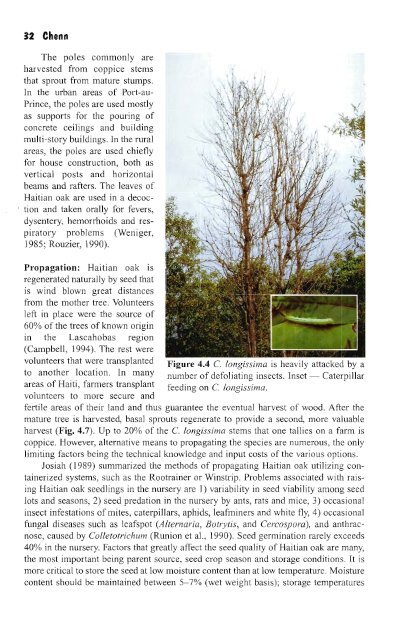Bwa-yo - Société Audubon Haiti
Bwa-yo - Société Audubon Haiti
Bwa-yo - Société Audubon Haiti
Create successful ePaper yourself
Turn your PDF publications into a flip-book with our unique Google optimized e-Paper software.
32 Chenn<br />
The poles commonly are<br />
harvested from coppice stems<br />
that sprout from mature stumps.<br />
In the urban areas of Port-au<br />
Prince, the poles are used mostly<br />
as supports for the pouring of<br />
concrete ceilings and building<br />
multi-story buildings. In the rural<br />
areas, the poles are used chiefly<br />
for house construction, both as<br />
vertical posts and horizontal<br />
beams and rafters. The leaves of<br />
<strong>Haiti</strong>an oak are used in a decoction<br />
and taken orally for fevers,<br />
dysentery, hemorrhoids and respiratory<br />
problems (Weniger,<br />
1985; Rouzier, 1990).<br />
Propagation: <strong>Haiti</strong>an oak is<br />
regenerated naturally by seed that<br />
is wind blown great distances<br />
from the mother tree. Volunteers<br />
left in place were the source of<br />
60% of the trees of known origin<br />
in the Lascahobas regIon<br />
(Campbell, 1994). The rest were<br />
volunteers that were transplanted<br />
to another location. In many<br />
areas of <strong>Haiti</strong>, farmers transplant<br />
volunteers to more secure and<br />
Figure 4.4 C. longissima is heavily attacked by a<br />
number of defoliating insects. Inset - Caterpillar<br />
feeding on C. longissima.<br />
fertile areas of their land and thus guarantee the eventual harvest of wood. After the<br />
mature tree is harvested, basal sprouts regenerate to provide a second, more valuable<br />
harvest (Fig. 4.7). Up to 20% of the C. longissima stems that one tallies on a farm is<br />
coppice. However, alternative means to propagating the species are numerous, the only<br />
limiting factors being the technical knowledge and input costs of the various options.<br />
Josiah (1989) summarized the methods of propagating <strong>Haiti</strong>an oak utilizing containerized<br />
systems, such as the Rootrainer or Winstrip. Problems associated with raising<br />
<strong>Haiti</strong>an oak seedlings in the nursery are I) variability in seed viability among seed<br />
lots and seasons, 2) seed predation in the nursery by ants, rats and mice, 3) occasional<br />
insect infestations of mites, caterpillars, aphids, leafminers and white fly, 4) occasional<br />
fungal diseases such as leafspot (Alternaria, Botrytis, and Cercospora), and anthracnose,<br />
caused by Colletotrichum (Runion et al., 1990). Seed germination rarely exceeds<br />
40% in the nursery. Factors that greatly affect the seed quality of <strong>Haiti</strong>an oak are many,<br />
the most important being parent source, seed crop season and storage conditions. It is<br />
more critical to store the seed at low moisture content than at low temperature. Moisture<br />
content should be maintained between 5-7% (wet weight basis); storage temperatures



